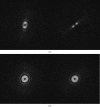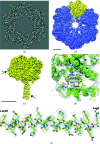Single-particle cryo-EM using alignment by classification (ABC): the structure of Lumbricus terrestris haemoglobin
- PMID: 28989723
- PMCID: PMC5619859
- DOI: 10.1107/S2052252517010922
Single-particle cryo-EM using alignment by classification (ABC): the structure of Lumbricus terrestris haemoglobin
Abstract
Single-particle cryogenic electron microscopy (cryo-EM) can now yield near-atomic resolution structures of biological complexes. However, the reference-based alignment algorithms commonly used in cryo-EM suffer from reference bias, limiting their applicability (also known as the 'Einstein from random noise' problem). Low-dose cryo-EM therefore requires robust and objective approaches to reveal the structural information contained in the extremely noisy data, especially when dealing with small structures. A reference-free pipeline is presented for obtaining near-atomic resolution three-dimensional reconstructions from heterogeneous ('four-dimensional') cryo-EM data sets. The methodologies integrated in this pipeline include a posteriori camera correction, movie-based full-data-set contrast transfer function determination, movie-alignment algorithms, (Fourier-space) multivariate statistical data compression and unsupervised classification, 'random-startup' three-dimensional reconstructions, four-dimensional structural refinements and Fourier shell correlation criteria for evaluating anisotropic resolution. The procedures exclusively use information emerging from the data set itself, without external 'starting models'. Euler-angle assignments are performed by angular reconstitution rather than by the inherently slower projection-matching approaches. The comprehensive 'ABC-4D' pipeline is based on the two-dimensional reference-free 'alignment by classification' (ABC) approach, where similar images in similar orientations are grouped by unsupervised classification. Some fundamental differences between X-ray crystallography versus single-particle cryo-EM data collection and data processing are discussed. The structure of the giant haemoglobin from Lumbricus terrestris at a global resolution of ∼3.8 Å is presented as an example of the use of the ABC-4D procedure.
Keywords: MSA; alignment by classification; angular reconstitution; cryo-EM; worm haemoglobin.
Figures













References
Grants and funding
LinkOut - more resources
Full Text Sources
Other Literature Sources

